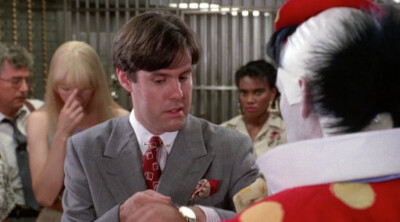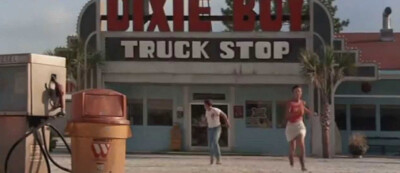5 Movie Scenes That Secretly Fixed Behind-the-Scenes Problems

Apart from drugs and thievery, where do Hollywood filmmakers get their creative ideas? Sometimes it's pure artistic inspiration, like when one lucky screenwriter hit on the gold mine that was pairing the mall security profession with a surname that rhymes with “fart.” But sometimes it turns out that these brilliant cinematic flourishes were secretly fixing real-world production issues most of us had no knowledge of, such as how ...
The Big Twist in Mulholland Drive Was Written Because All the Sets and Costumes Were Destroyed
It turns out that popular YouTuber David Lynch has made a few movies too. One of Lynch’s most universally-acclaimed films is Mulholland Drive, which tells the story of an upbeat aspiring actress named Betty and a mysterious amnesiac called Rita, who find themselves smack in the middle of a mystery involving multiple murders, the shadowy machinations of the entertainment industry, and the world’s most cursed Denny’s -- which sure is saying something. In an appropriately Lynchian twist, towards the end of the movie (SPOILERS for a twenty-year-old movie that defies spoiling) realities shift and Betty is suddenly revealed to be a woman named Diane, the bitter, jilted ex of Camilla, formerly Rita. Oh also Diane was probably dead the whole time or something.
While theories range from the first part of the story representing Diane’s “fugue state fantasy” to the whole thing somehow being an elaborate allegory for “Britain's declining public services” there’s no doubt that the dimension-contorting ending is what made the movie so memorable. One critic’s poll even concluded that Mulholland Drive is the greatest film of the 21st century. Amazingly, though, the surreal conceit of the third act wasn’t always a part of the plan, and was concocted purely to solve a major behind-the-scenes mess. Mulholland Drive, as strange as it might seem in retrospect, began the same way Full House did: as a TV pilot for ABC.
Months after the network rejected the series, a French studio offered to buy the pilot and turn it into a movie -- which wasn’t easy, it required additional shooting, renegotiating actors’ fees, and securing the rights to the original footage. Unfortunately, while the deal was being put together, Lynch discovered that ABC had lost track of all of the original costumes and the sets were in ruins, which made simply picking up where they left off an impossibility.
Lynch then tried to get out of the movie, but one of the producers, who thought the director was being a “baby,” told Lynch that he’d convinced Disney to take legal action if they didn’t go through with the deal. Then, perhaps not coincidentally, the same night his producer threatened to sue him with the help of one of the largest corporations on Earth, Lynch meditated and suddenly “knew exactly how to finish the movie” -- which involved, for the most part, the actors returning as entirely new characters who wouldn’t require the same clothes or living spaces.
Bill Murray Had His Fancy Watch Written Into a Bank Heist Scene
When you think about Bill Murray, you probably picture his iconic roles such as Peter Venkman in Ghostbusters, or Phil Connors in Groundhog Day, or Phil Connors in Groundhog Day, or Phil C -- but one of Murray’s most underrated performances came in the 1990 comedy Quick Change, about a trio of bank robbers who commit the perfect crime, but have trouble making it to the airport. Oh, and Murray’s character is dressed like a clown during the heist, yet it sadly made only a fraction of what Joker did at the box office.
In one early scene from Quick Change (which was also co-written and co-directed by Murray) one of the bank hostages, a sleazy ‘80s yuppie, attempts to bribe the gun-toting clown by handing over his expensive watch.

Warner Bros.

Warner Bros.
According to Murray’s writing and directing partner, Howard Franklin, this scene wasn’t an incidental bit of comedy, it was specifically written at the behest of Murray. Why? Apparently that was Bill Murray’s actual watch -- a watch so extravagant that it had to be wound at a fancy store, at a cost of $150, if unused for a prolonged period of time. Bill was “pissed off” at having to pay the crazy fee every time he took the watch off for months at a time for film shoots, so he specifically told Franklin: “I’d really like you to write this watch into the movie.” Thanks to this scene, despite the fact that he is a low-level crook, Murray’s character spends the entire movie wearing a watch that one could only realistically afford with a Ghostbusters II paycheck.
The Warriors -- Fox’s Tragic Death Was Part of a Last Minute Decision to Fire the Actor
Easily the greatest movie of all-time that prominently features a gang of murderous baseball players in KISS make-up --
-- Walter Hill’s classic 1979 thriller The Warriors tells the story of the titular group of street thugs who have to navigate the menacing/increasingly goofy New York streets on their way home to Coney Island. Despite the heightened sense of realism, what makes the movie work so well is that it still has a grounded sense of danger. One of the most impactful moments that contributes to establishing these high stakes, is the tragic death of Fox, the member of the Warriors who gets beaten up by a cop and thrown into the path of an oncoming subway train.
But despite how meaningfully consequential Fox’s death turned out to be in the overall story, this wasn’t originally in the script. It turns out that this harrowing scene was thrown together at the last minute purely because the actor who played Fox, Thomas G. Waites, was being … kind of a dick. According to Waites, he continually complained to Hill that the movie “was too violent” to which Hill responded: “Shut the f*ck up, you’re just the actor.” After eight weeks, Hill fired the actor, and solved his absence by simply putting a Warriors vest on a crew member and having him thrown in front of a goddamn train. Which is only slightly less of an F-you than just hiring Christopher Plummer to take your place.
The Crew of I Know What You Did Last Summer Fulfilled the Demands of a Contest Winner … and Created an Iconic Moment
If there’s one thing the ‘90s teen slasher movie I Know What You Did Last Summer is known for (apart from angering and possibly re-traumatizing the original novel’s author) it’s the scene where Jennifer Love Hewitt stands in the middle of the road and screams “What are you waiting for?!” at the heavens while spinning around like a drunken Olympic figure skater who’s super-into Nickelback.
Surely this iconic moment was carefully planned out from the beginning, right? Nope. As revealed by Hewitt, we have some random anonymous child to thank. It turns out that a kid had won a contest to visit the set of the fim -- and rather than send them on a day that featured a gruesome murder committed by a fish hook-wielding madman, they were there for this particular shot. According to Hewitt, the scene was directed by the kid who “thought it would be interesting to have her character start screaming in the street.” The crew “decided to humor him,” seeing as he won a contest and all, but soon realized that it was “amazing.” Why did no one think to hire this small child to helm the sequel?
Breakdown Was An Attempt To Salvage a Failed Maximum Overdrive Remake
Kurt Russell has starred in some of the most exciting films of all-time; Escape From New York, The Thing, those movies where Santa Claus travels through time and hunts mythical snow beasts. But one of his very best, which doesn’t get nearly the credit it deserves, is Breakdown, the 1997 thriller about a guy whose car randomly craps out, which sets in motion a series of events that lead to his wife’s disappearance. Great movie, terrible product placement for the Jeep Grand Cherokee.
Weirdly, this masterpiece of suspense began as … a different movie entirely. The production started as a remake of the notorious ‘80s horror movie Maximum Overdrive, directed by Stephen King and executive produced by cocaine. One of the producers was Hollywood legend/complete maniac Dino De Laurentiis, who convinced King to get involved with the project after purchasing the rights to his short story Trucks. For his ‘90s version of the same story, De Laurentiis hired director Jonathan Mostow, who began scouting locations and prepping the shoot.
Unfortunately for everyone except perhaps the movie-viewing public, De Laurentiis cancelled the Maximum Overdrive remake when he found out that, for legal reasons, he wouldn’t be allowed to advertise the film with Stephen King’s name in the title. According to Mostow, the fledgling director then scrambled to save his first big Hollywood gig, and threw together a new story that could “salvage the situation” and utilize much of the pre-production work that had already been done. Which makes total sense in retrospect, both movies feature scenes with sinister big-rigs.

Paramount Pictures

De Laurentiis Entertainment Group
And the primary location, in both films, is a crappy truck stop diner in the middle of nowhere.

Paramount Pictures

De Laurentiis Entertainment Group
But somehow Breakdown took the same basic ingredients and used them to make what you can only imagine is a better movie than what they were originally going to make -- which, and again we can’t stress this enough, was a remake of a movie that literally features a dude getting hit in the nuts by an evil soda can-dispensing vending machine.
You (yes, you) should follow JM on Twitter! And check out the podcast Rewatchability.
Top Image: Universal Pictures